Analyzing Child Development Through Observation Techniques: A Study
VerifiedAdded on 2022/08/29
|15
|4080
|42
Practical Assignment
AI Summary
This assignment provides a comprehensive analysis of observation techniques used in early childhood education. The paper presents three different observation methods: event recording, running records, and time recording. The event recording example focuses on a 2-year-old child's play routine in a daycare setting, detailing the child's behaviors and interactions. The running records example observes an infant's play and routine in a daycare center, documenting the child's movements and reactions to the environment. The time recording example focuses on a three- or four-year-old child in an outdoor play area, recording the child's emotional and social development through different play types. The observations are analyzed to understand child behavior, interactions, and development in alignment with the principles of 'Being, Belonging, and Becoming' in the Australian Government Education and Training framework. The assignment aims to provide a holistic view of each child and assess their individual progress.

Running Head: SOCIOLOGY 1
Early Childhood Education and Care
Name of University
Early Childhood Education and Care
Name of University
Paraphrase This Document
Need a fresh take? Get an instant paraphrase of this document with our AI Paraphraser
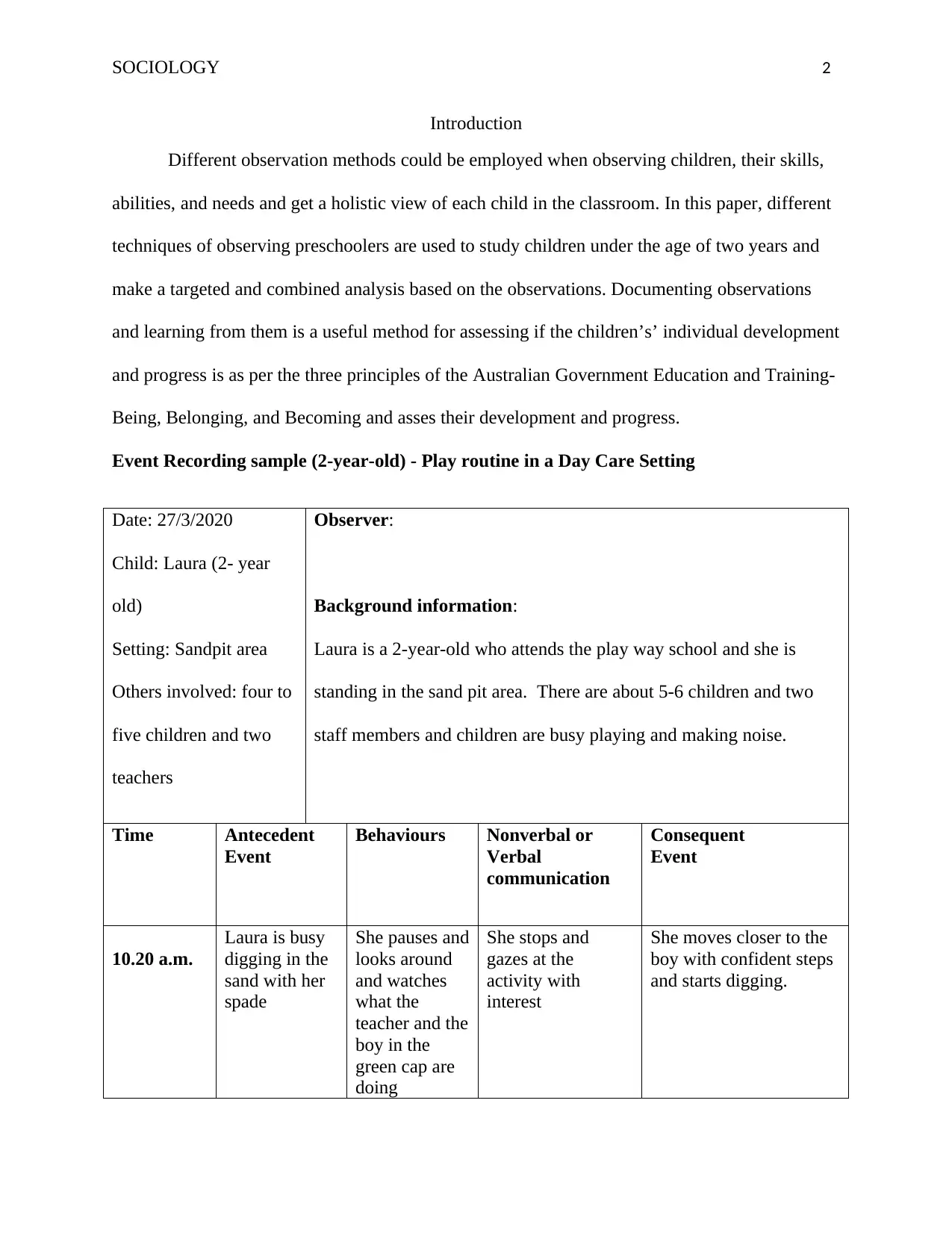
SOCIOLOGY 2
Introduction
Different observation methods could be employed when observing children, their skills,
abilities, and needs and get a holistic view of each child in the classroom. In this paper, different
techniques of observing preschoolers are used to study children under the age of two years and
make a targeted and combined analysis based on the observations. Documenting observations
and learning from them is a useful method for assessing if the children’s’ individual development
and progress is as per the three principles of the Australian Government Education and Training-
Being, Belonging, and Becoming and asses their development and progress.
Event Recording sample (2-year-old) - Play routine in a Day Care Setting
Date: 27/3/2020
Child: Laura (2- year
old)
Setting: Sandpit area
Others involved: four to
five children and two
teachers
Observer:
Background information:
Laura is a 2-year-old who attends the play way school and she is
standing in the sand pit area. There are about 5-6 children and two
staff members and children are busy playing and making noise.
Time Antecedent
Event
Behaviours Nonverbal or
Verbal
communication
Consequent
Event
10.20 a.m.
Laura is busy
digging in the
sand with her
spade
She pauses and
looks around
and watches
what the
teacher and the
boy in the
green cap are
doing
She stops and
gazes at the
activity with
interest
She moves closer to the
boy with confident steps
and starts digging.
Introduction
Different observation methods could be employed when observing children, their skills,
abilities, and needs and get a holistic view of each child in the classroom. In this paper, different
techniques of observing preschoolers are used to study children under the age of two years and
make a targeted and combined analysis based on the observations. Documenting observations
and learning from them is a useful method for assessing if the children’s’ individual development
and progress is as per the three principles of the Australian Government Education and Training-
Being, Belonging, and Becoming and asses their development and progress.
Event Recording sample (2-year-old) - Play routine in a Day Care Setting
Date: 27/3/2020
Child: Laura (2- year
old)
Setting: Sandpit area
Others involved: four to
five children and two
teachers
Observer:
Background information:
Laura is a 2-year-old who attends the play way school and she is
standing in the sand pit area. There are about 5-6 children and two
staff members and children are busy playing and making noise.
Time Antecedent
Event
Behaviours Nonverbal or
Verbal
communication
Consequent
Event
10.20 a.m.
Laura is busy
digging in the
sand with her
spade
She pauses and
looks around
and watches
what the
teacher and the
boy in the
green cap are
doing
She stops and
gazes at the
activity with
interest
She moves closer to the
boy with confident steps
and starts digging.
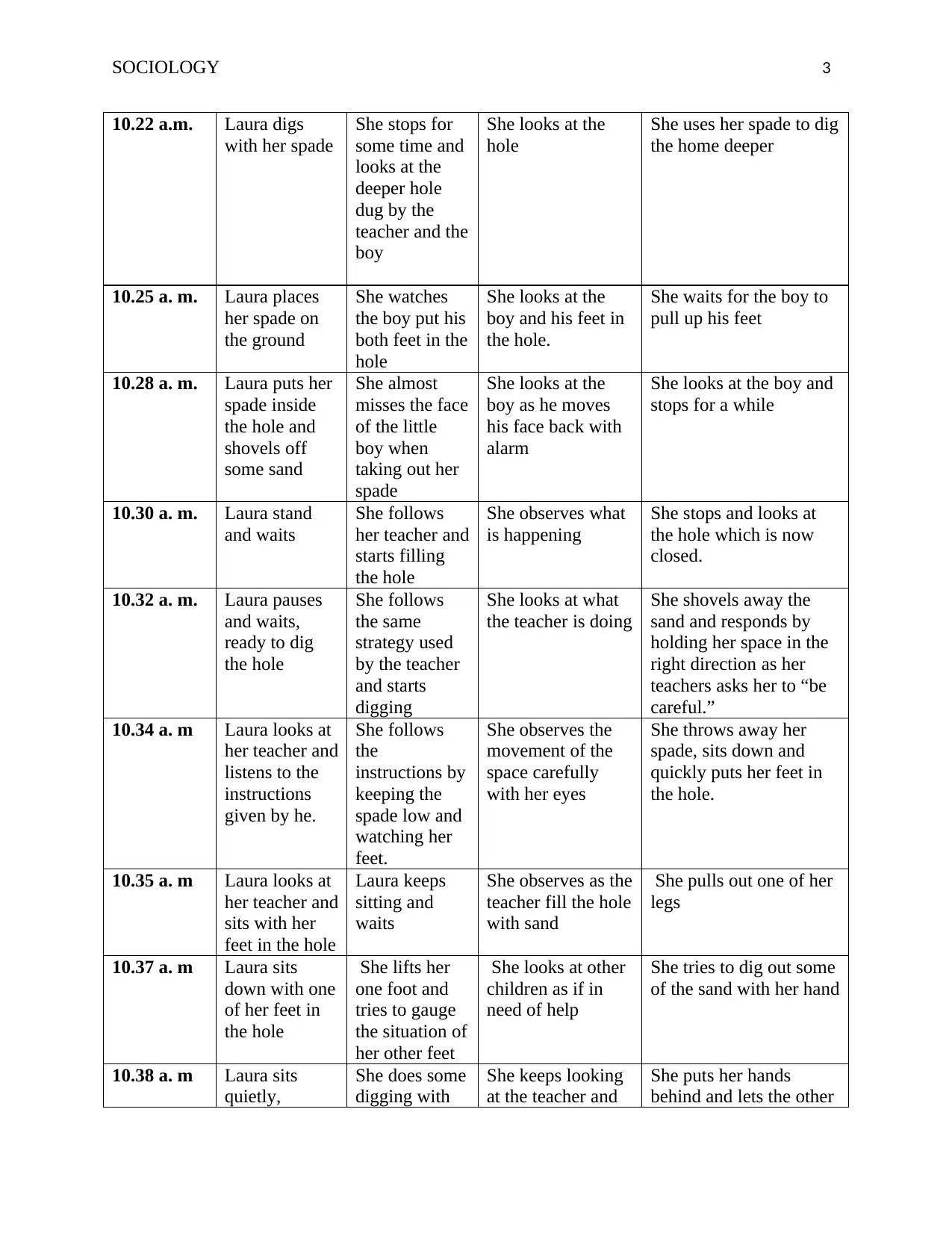
SOCIOLOGY 3
10.22 a.m. Laura digs
with her spade
She stops for
some time and
looks at the
deeper hole
dug by the
teacher and the
boy
She looks at the
hole
She uses her spade to dig
the home deeper
10.25 a. m. Laura places
her spade on
the ground
She watches
the boy put his
both feet in the
hole
She looks at the
boy and his feet in
the hole.
She waits for the boy to
pull up his feet
10.28 a. m. Laura puts her
spade inside
the hole and
shovels off
some sand
She almost
misses the face
of the little
boy when
taking out her
spade
She looks at the
boy as he moves
his face back with
alarm
She looks at the boy and
stops for a while
10.30 a. m. Laura stand
and waits
She follows
her teacher and
starts filling
the hole
She observes what
is happening
She stops and looks at
the hole which is now
closed.
10.32 a. m. Laura pauses
and waits,
ready to dig
the hole
She follows
the same
strategy used
by the teacher
and starts
digging
She looks at what
the teacher is doing
She shovels away the
sand and responds by
holding her space in the
right direction as her
teachers asks her to “be
careful.”
10.34 a. m Laura looks at
her teacher and
listens to the
instructions
given by he.
She follows
the
instructions by
keeping the
spade low and
watching her
feet.
She observes the
movement of the
space carefully
with her eyes
She throws away her
spade, sits down and
quickly puts her feet in
the hole.
10.35 a. m Laura looks at
her teacher and
sits with her
feet in the hole
Laura keeps
sitting and
waits
She observes as the
teacher fill the hole
with sand
She pulls out one of her
legs
10.37 a. m Laura sits
down with one
of her feet in
the hole
She lifts her
one foot and
tries to gauge
the situation of
her other feet
She looks at other
children as if in
need of help
She tries to dig out some
of the sand with her hand
10.38 a. m Laura sits
quietly,
She does some
digging with
She keeps looking
at the teacher and
She puts her hands
behind and lets the other
10.22 a.m. Laura digs
with her spade
She stops for
some time and
looks at the
deeper hole
dug by the
teacher and the
boy
She looks at the
hole
She uses her spade to dig
the home deeper
10.25 a. m. Laura places
her spade on
the ground
She watches
the boy put his
both feet in the
hole
She looks at the
boy and his feet in
the hole.
She waits for the boy to
pull up his feet
10.28 a. m. Laura puts her
spade inside
the hole and
shovels off
some sand
She almost
misses the face
of the little
boy when
taking out her
spade
She looks at the
boy as he moves
his face back with
alarm
She looks at the boy and
stops for a while
10.30 a. m. Laura stand
and waits
She follows
her teacher and
starts filling
the hole
She observes what
is happening
She stops and looks at
the hole which is now
closed.
10.32 a. m. Laura pauses
and waits,
ready to dig
the hole
She follows
the same
strategy used
by the teacher
and starts
digging
She looks at what
the teacher is doing
She shovels away the
sand and responds by
holding her space in the
right direction as her
teachers asks her to “be
careful.”
10.34 a. m Laura looks at
her teacher and
listens to the
instructions
given by he.
She follows
the
instructions by
keeping the
spade low and
watching her
feet.
She observes the
movement of the
space carefully
with her eyes
She throws away her
spade, sits down and
quickly puts her feet in
the hole.
10.35 a. m Laura looks at
her teacher and
sits with her
feet in the hole
Laura keeps
sitting and
waits
She observes as the
teacher fill the hole
with sand
She pulls out one of her
legs
10.37 a. m Laura sits
down with one
of her feet in
the hole
She lifts her
one foot and
tries to gauge
the situation of
her other feet
She looks at other
children as if in
need of help
She tries to dig out some
of the sand with her hand
10.38 a. m Laura sits
quietly,
She does some
digging with
She keeps looking
at the teacher and
She puts her hands
behind and lets the other
⊘ This is a preview!⊘
Do you want full access?
Subscribe today to unlock all pages.

Trusted by 1+ million students worldwide
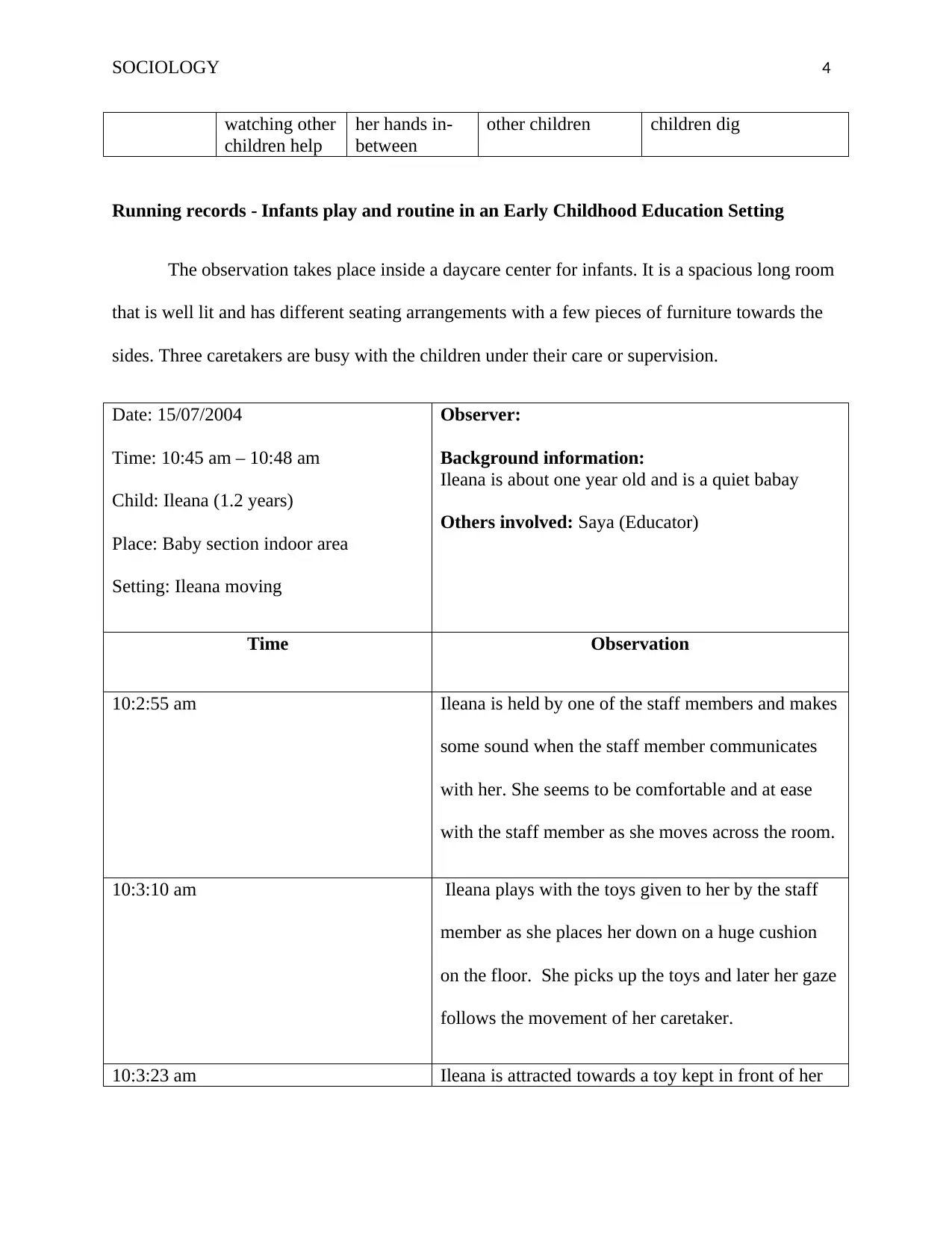
SOCIOLOGY 4
watching other
children help
her hands in-
between
other children children dig
Running records - Infants play and routine in an Early Childhood Education Setting
The observation takes place inside a daycare center for infants. It is a spacious long room
that is well lit and has different seating arrangements with a few pieces of furniture towards the
sides. Three caretakers are busy with the children under their care or supervision.
Date: 15/07/2004
Time: 10:45 am – 10:48 am
Child: Ileana (1.2 years)
Place: Baby section indoor area
Setting: Ileana moving
Observer:
Background information:
Ileana is about one year old and is a quiet babay
Others involved: Saya (Educator)
Time Observation
10:2:55 am Ileana is held by one of the staff members and makes
some sound when the staff member communicates
with her. She seems to be comfortable and at ease
with the staff member as she moves across the room.
10:3:10 am Ileana plays with the toys given to her by the staff
member as she places her down on a huge cushion
on the floor. She picks up the toys and later her gaze
follows the movement of her caretaker.
10:3:23 am Ileana is attracted towards a toy kept in front of her
watching other
children help
her hands in-
between
other children children dig
Running records - Infants play and routine in an Early Childhood Education Setting
The observation takes place inside a daycare center for infants. It is a spacious long room
that is well lit and has different seating arrangements with a few pieces of furniture towards the
sides. Three caretakers are busy with the children under their care or supervision.
Date: 15/07/2004
Time: 10:45 am – 10:48 am
Child: Ileana (1.2 years)
Place: Baby section indoor area
Setting: Ileana moving
Observer:
Background information:
Ileana is about one year old and is a quiet babay
Others involved: Saya (Educator)
Time Observation
10:2:55 am Ileana is held by one of the staff members and makes
some sound when the staff member communicates
with her. She seems to be comfortable and at ease
with the staff member as she moves across the room.
10:3:10 am Ileana plays with the toys given to her by the staff
member as she places her down on a huge cushion
on the floor. She picks up the toys and later her gaze
follows the movement of her caretaker.
10:3:23 am Ileana is attracted towards a toy kept in front of her
Paraphrase This Document
Need a fresh take? Get an instant paraphrase of this document with our AI Paraphraser
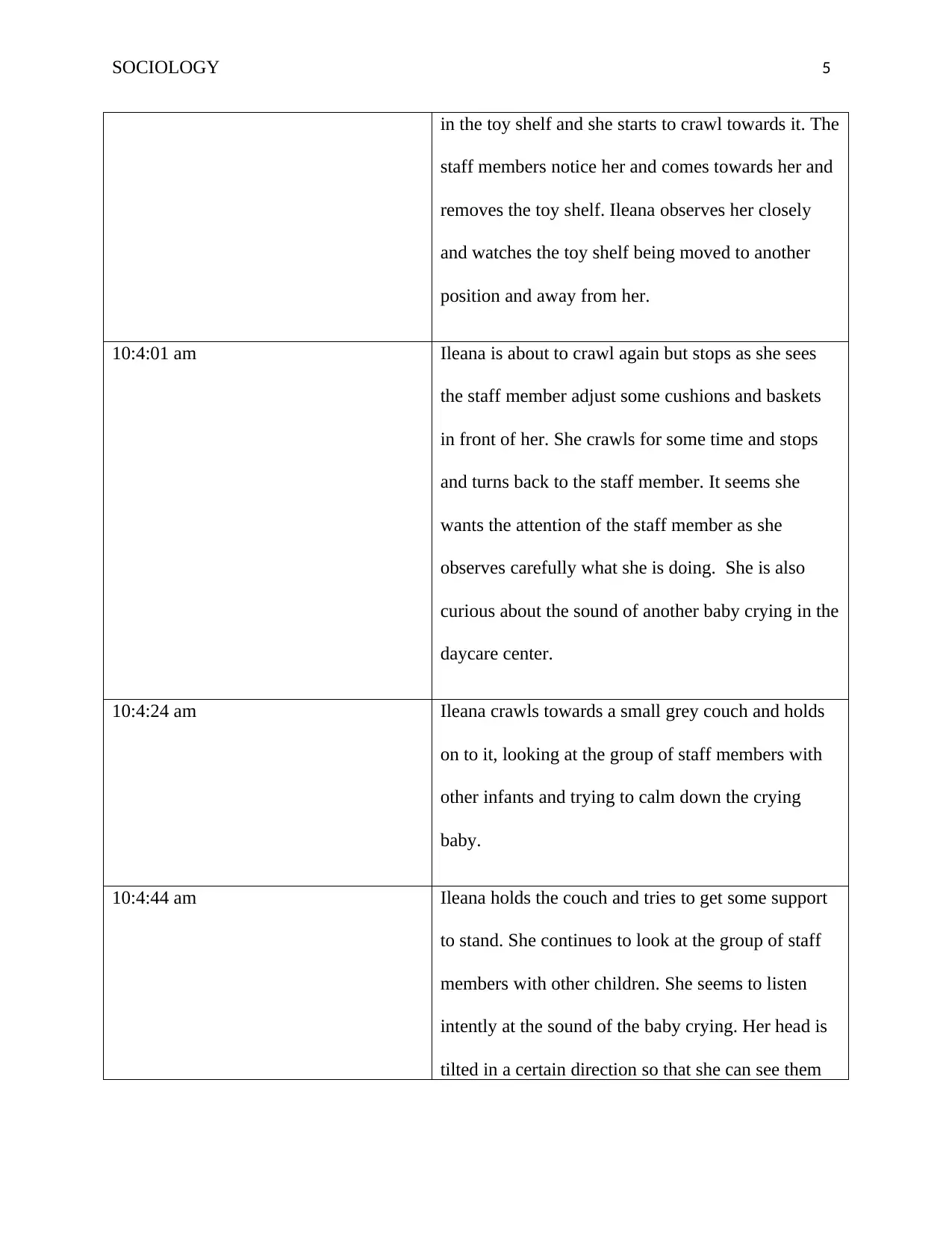
SOCIOLOGY 5
in the toy shelf and she starts to crawl towards it. The
staff members notice her and comes towards her and
removes the toy shelf. Ileana observes her closely
and watches the toy shelf being moved to another
position and away from her.
10:4:01 am Ileana is about to crawl again but stops as she sees
the staff member adjust some cushions and baskets
in front of her. She crawls for some time and stops
and turns back to the staff member. It seems she
wants the attention of the staff member as she
observes carefully what she is doing. She is also
curious about the sound of another baby crying in the
daycare center.
10:4:24 am Ileana crawls towards a small grey couch and holds
on to it, looking at the group of staff members with
other infants and trying to calm down the crying
baby.
10:4:44 am Ileana holds the couch and tries to get some support
to stand. She continues to look at the group of staff
members with other children. She seems to listen
intently at the sound of the baby crying. Her head is
tilted in a certain direction so that she can see them
in the toy shelf and she starts to crawl towards it. The
staff members notice her and comes towards her and
removes the toy shelf. Ileana observes her closely
and watches the toy shelf being moved to another
position and away from her.
10:4:01 am Ileana is about to crawl again but stops as she sees
the staff member adjust some cushions and baskets
in front of her. She crawls for some time and stops
and turns back to the staff member. It seems she
wants the attention of the staff member as she
observes carefully what she is doing. She is also
curious about the sound of another baby crying in the
daycare center.
10:4:24 am Ileana crawls towards a small grey couch and holds
on to it, looking at the group of staff members with
other infants and trying to calm down the crying
baby.
10:4:44 am Ileana holds the couch and tries to get some support
to stand. She continues to look at the group of staff
members with other children. She seems to listen
intently at the sound of the baby crying. Her head is
tilted in a certain direction so that she can see them
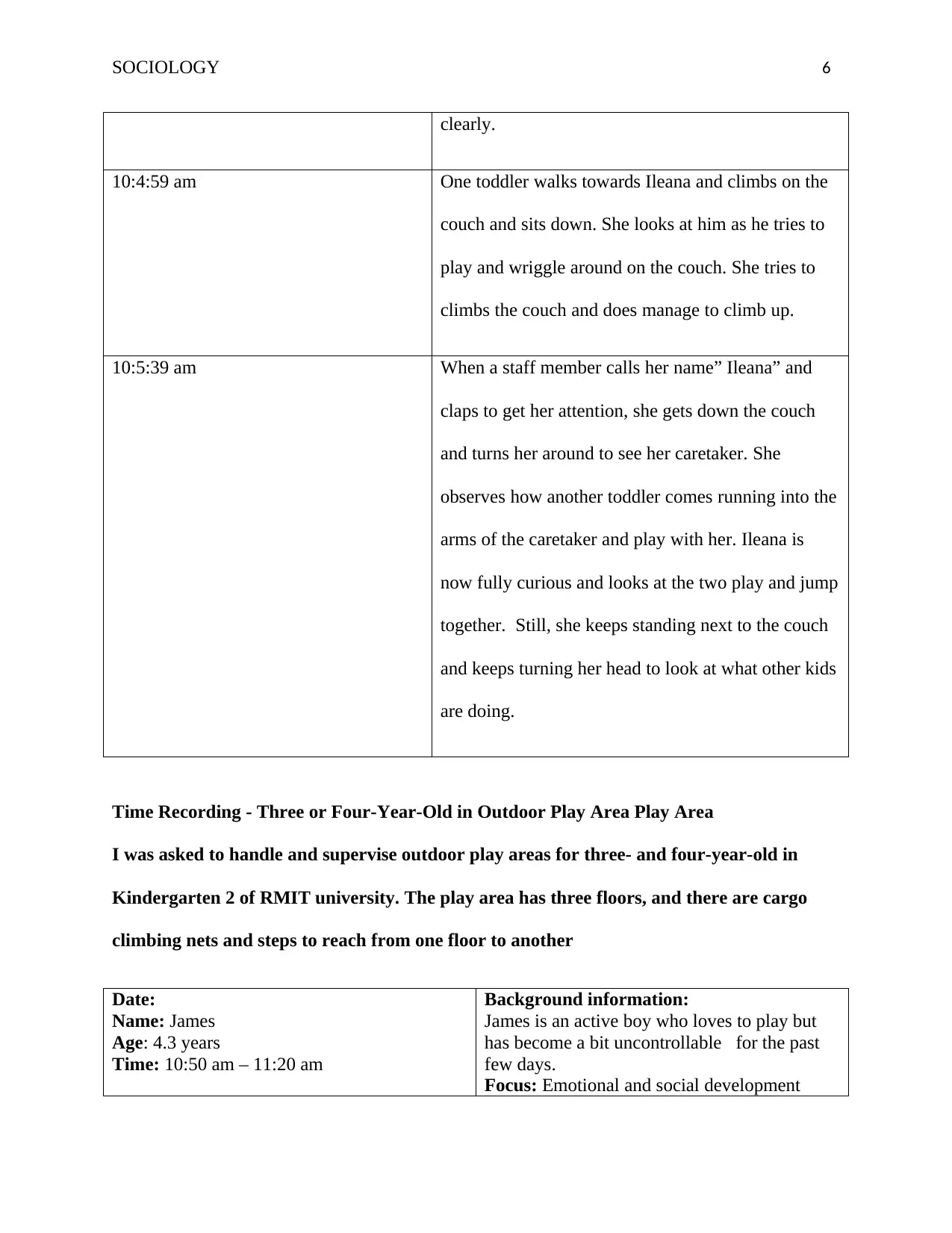
SOCIOLOGY 6
clearly.
10:4:59 am One toddler walks towards Ileana and climbs on the
couch and sits down. She looks at him as he tries to
play and wriggle around on the couch. She tries to
climbs the couch and does manage to climb up.
10:5:39 am When a staff member calls her name” Ileana” and
claps to get her attention, she gets down the couch
and turns her around to see her caretaker. She
observes how another toddler comes running into the
arms of the caretaker and play with her. Ileana is
now fully curious and looks at the two play and jump
together. Still, she keeps standing next to the couch
and keeps turning her head to look at what other kids
are doing.
Time Recording - Three or Four-Year-Old in Outdoor Play Area Play Area
I was asked to handle and supervise outdoor play areas for three- and four-year-old in
Kindergarten 2 of RMIT university. The play area has three floors, and there are cargo
climbing nets and steps to reach from one floor to another
Date:
Name: James
Age: 4.3 years
Time: 10:50 am – 11:20 am
Background information:
James is an active boy who loves to play but
has become a bit uncontrollable for the past
few days.
Focus: Emotional and social development
clearly.
10:4:59 am One toddler walks towards Ileana and climbs on the
couch and sits down. She looks at him as he tries to
play and wriggle around on the couch. She tries to
climbs the couch and does manage to climb up.
10:5:39 am When a staff member calls her name” Ileana” and
claps to get her attention, she gets down the couch
and turns her around to see her caretaker. She
observes how another toddler comes running into the
arms of the caretaker and play with her. Ileana is
now fully curious and looks at the two play and jump
together. Still, she keeps standing next to the couch
and keeps turning her head to look at what other kids
are doing.
Time Recording - Three or Four-Year-Old in Outdoor Play Area Play Area
I was asked to handle and supervise outdoor play areas for three- and four-year-old in
Kindergarten 2 of RMIT university. The play area has three floors, and there are cargo
climbing nets and steps to reach from one floor to another
Date:
Name: James
Age: 4.3 years
Time: 10:50 am – 11:20 am
Background information:
James is an active boy who loves to play but
has become a bit uncontrollable for the past
few days.
Focus: Emotional and social development
⊘ This is a preview!⊘
Do you want full access?
Subscribe today to unlock all pages.

Trusted by 1+ million students worldwide
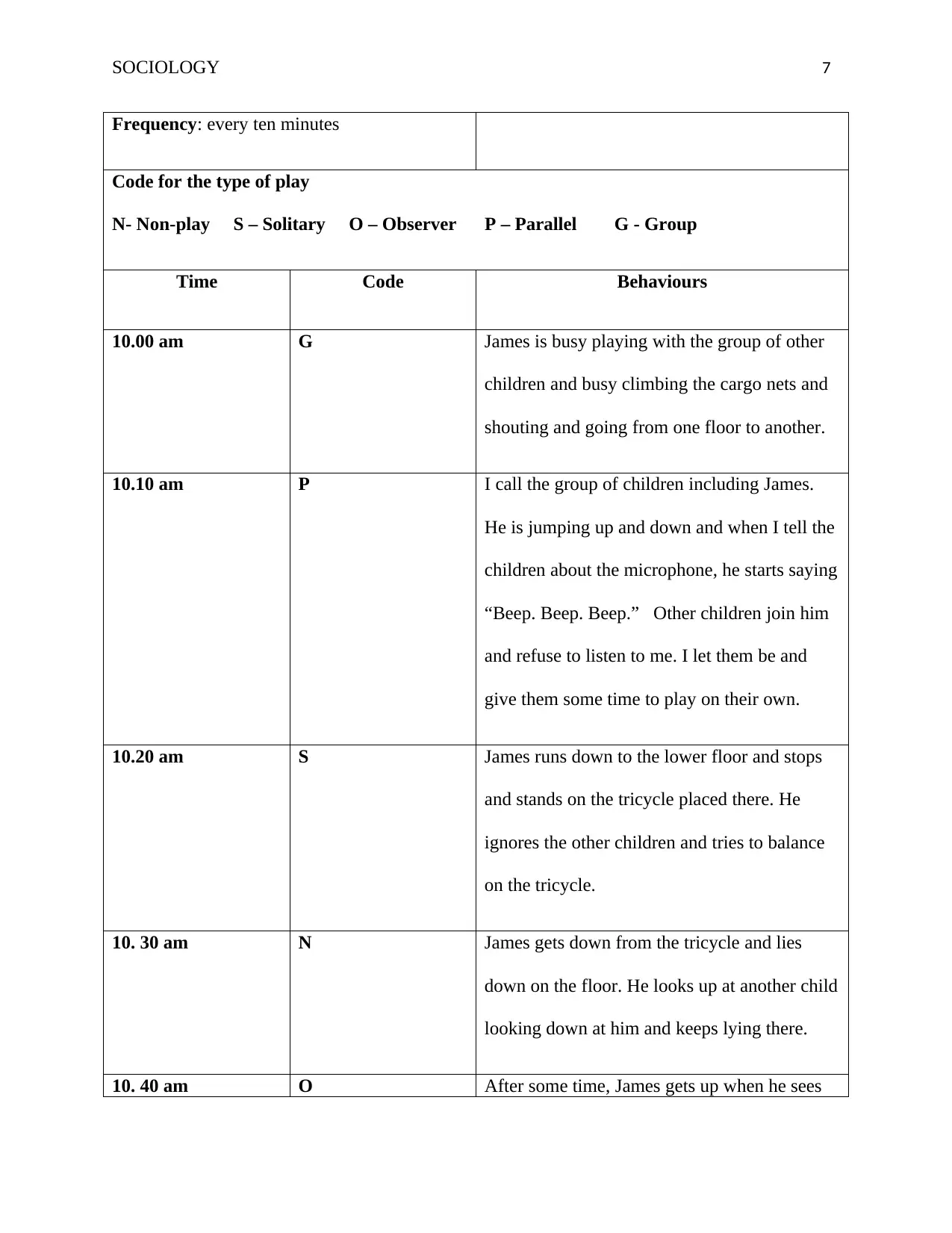
SOCIOLOGY 7
Frequency: every ten minutes
Code for the type of play
N- Non-play S – Solitary O – Observer P – Parallel G - Group
Time Code Behaviours
10.00 am G James is busy playing with the group of other
children and busy climbing the cargo nets and
shouting and going from one floor to another.
10.10 am P I call the group of children including James.
He is jumping up and down and when I tell the
children about the microphone, he starts saying
“Beep. Beep. Beep.” Other children join him
and refuse to listen to me. I let them be and
give them some time to play on their own.
10.20 am S James runs down to the lower floor and stops
and stands on the tricycle placed there. He
ignores the other children and tries to balance
on the tricycle.
10. 30 am N James gets down from the tricycle and lies
down on the floor. He looks up at another child
looking down at him and keeps lying there.
10. 40 am O After some time, James gets up when he sees
Frequency: every ten minutes
Code for the type of play
N- Non-play S – Solitary O – Observer P – Parallel G - Group
Time Code Behaviours
10.00 am G James is busy playing with the group of other
children and busy climbing the cargo nets and
shouting and going from one floor to another.
10.10 am P I call the group of children including James.
He is jumping up and down and when I tell the
children about the microphone, he starts saying
“Beep. Beep. Beep.” Other children join him
and refuse to listen to me. I let them be and
give them some time to play on their own.
10.20 am S James runs down to the lower floor and stops
and stands on the tricycle placed there. He
ignores the other children and tries to balance
on the tricycle.
10. 30 am N James gets down from the tricycle and lies
down on the floor. He looks up at another child
looking down at him and keeps lying there.
10. 40 am O After some time, James gets up when he sees
Paraphrase This Document
Need a fresh take? Get an instant paraphrase of this document with our AI Paraphraser
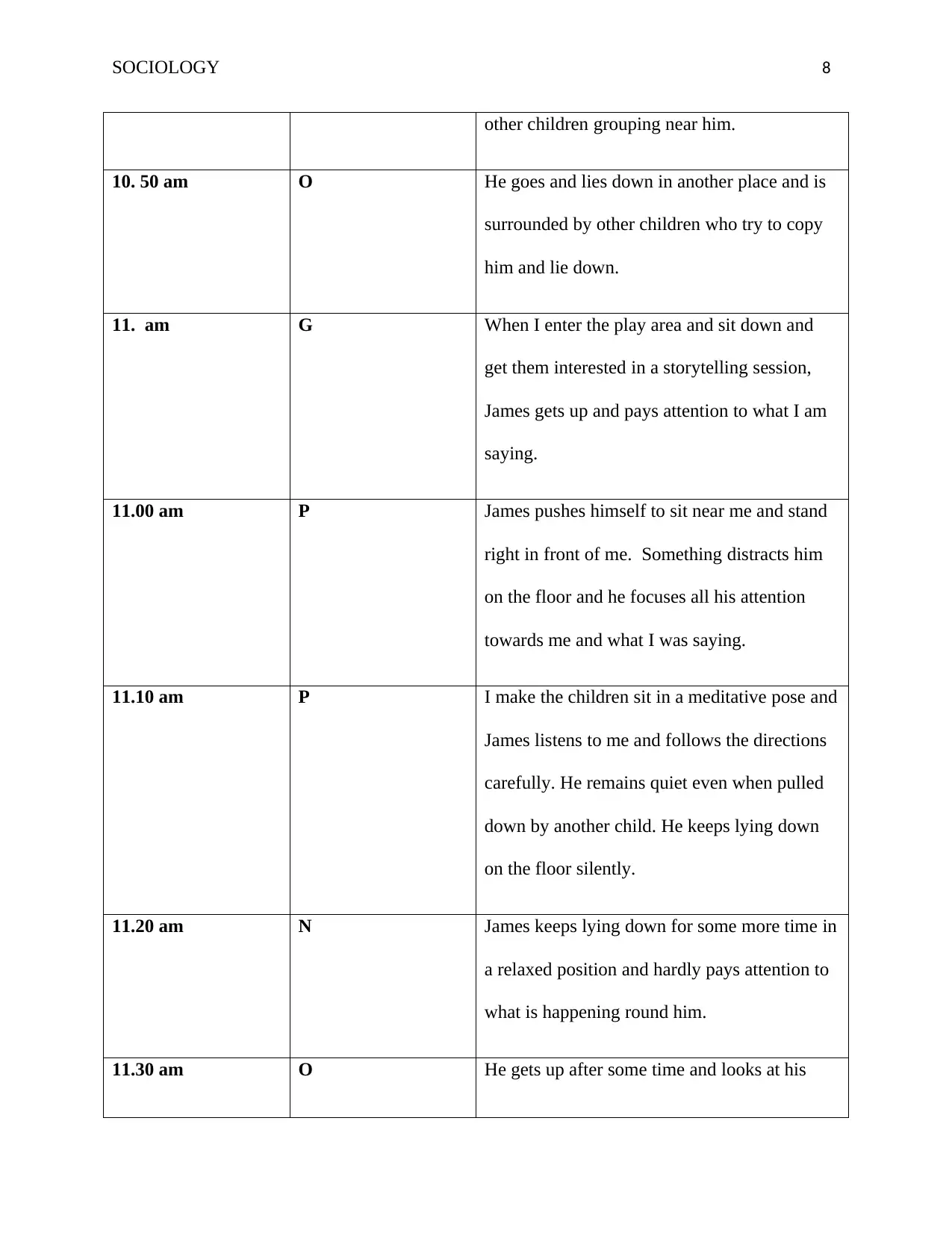
SOCIOLOGY 8
other children grouping near him.
10. 50 am O He goes and lies down in another place and is
surrounded by other children who try to copy
him and lie down.
11. am G When I enter the play area and sit down and
get them interested in a storytelling session,
James gets up and pays attention to what I am
saying.
11.00 am P James pushes himself to sit near me and stand
right in front of me. Something distracts him
on the floor and he focuses all his attention
towards me and what I was saying.
11.10 am P I make the children sit in a meditative pose and
James listens to me and follows the directions
carefully. He remains quiet even when pulled
down by another child. He keeps lying down
on the floor silently.
11.20 am N James keeps lying down for some more time in
a relaxed position and hardly pays attention to
what is happening round him.
11.30 am O He gets up after some time and looks at his
other children grouping near him.
10. 50 am O He goes and lies down in another place and is
surrounded by other children who try to copy
him and lie down.
11. am G When I enter the play area and sit down and
get them interested in a storytelling session,
James gets up and pays attention to what I am
saying.
11.00 am P James pushes himself to sit near me and stand
right in front of me. Something distracts him
on the floor and he focuses all his attention
towards me and what I was saying.
11.10 am P I make the children sit in a meditative pose and
James listens to me and follows the directions
carefully. He remains quiet even when pulled
down by another child. He keeps lying down
on the floor silently.
11.20 am N James keeps lying down for some more time in
a relaxed position and hardly pays attention to
what is happening round him.
11.30 am O He gets up after some time and looks at his
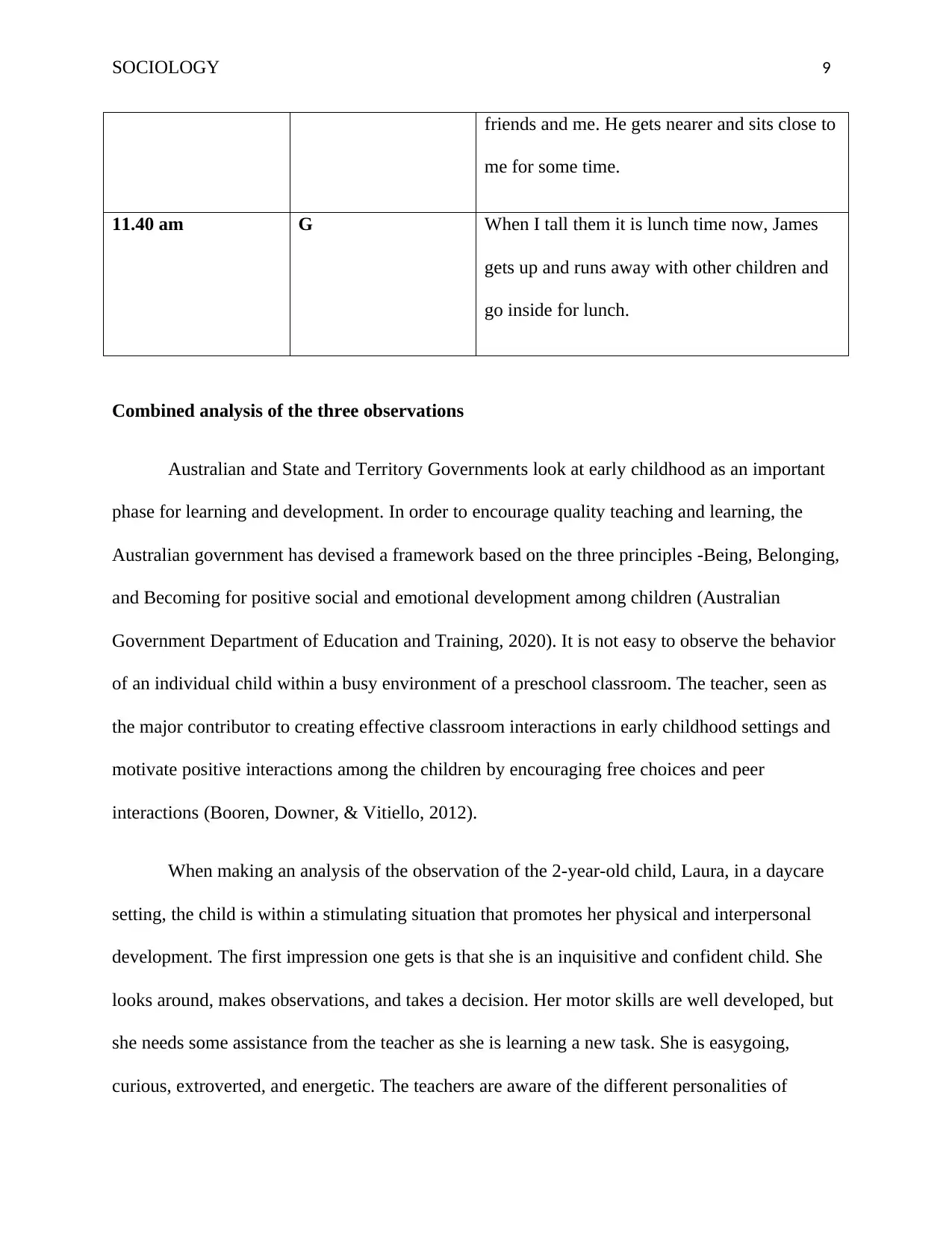
SOCIOLOGY 9
friends and me. He gets nearer and sits close to
me for some time.
11.40 am G When I tall them it is lunch time now, James
gets up and runs away with other children and
go inside for lunch.
Combined analysis of the three observations
Australian and State and Territory Governments look at early childhood as an important
phase for learning and development. In order to encourage quality teaching and learning, the
Australian government has devised a framework based on the three principles -Being, Belonging,
and Becoming for positive social and emotional development among children (Australian
Government Department of Education and Training, 2020). It is not easy to observe the behavior
of an individual child within a busy environment of a preschool classroom. The teacher, seen as
the major contributor to creating effective classroom interactions in early childhood settings and
motivate positive interactions among the children by encouraging free choices and peer
interactions (Booren, Downer, & Vitiello, 2012).
When making an analysis of the observation of the 2-year-old child, Laura, in a daycare
setting, the child is within a stimulating situation that promotes her physical and interpersonal
development. The first impression one gets is that she is an inquisitive and confident child. She
looks around, makes observations, and takes a decision. Her motor skills are well developed, but
she needs some assistance from the teacher as she is learning a new task. She is easygoing,
curious, extroverted, and energetic. The teachers are aware of the different personalities of
friends and me. He gets nearer and sits close to
me for some time.
11.40 am G When I tall them it is lunch time now, James
gets up and runs away with other children and
go inside for lunch.
Combined analysis of the three observations
Australian and State and Territory Governments look at early childhood as an important
phase for learning and development. In order to encourage quality teaching and learning, the
Australian government has devised a framework based on the three principles -Being, Belonging,
and Becoming for positive social and emotional development among children (Australian
Government Department of Education and Training, 2020). It is not easy to observe the behavior
of an individual child within a busy environment of a preschool classroom. The teacher, seen as
the major contributor to creating effective classroom interactions in early childhood settings and
motivate positive interactions among the children by encouraging free choices and peer
interactions (Booren, Downer, & Vitiello, 2012).
When making an analysis of the observation of the 2-year-old child, Laura, in a daycare
setting, the child is within a stimulating situation that promotes her physical and interpersonal
development. The first impression one gets is that she is an inquisitive and confident child. She
looks around, makes observations, and takes a decision. Her motor skills are well developed, but
she needs some assistance from the teacher as she is learning a new task. She is easygoing,
curious, extroverted, and energetic. The teachers are aware of the different personalities of
⊘ This is a preview!⊘
Do you want full access?
Subscribe today to unlock all pages.

Trusted by 1+ million students worldwide
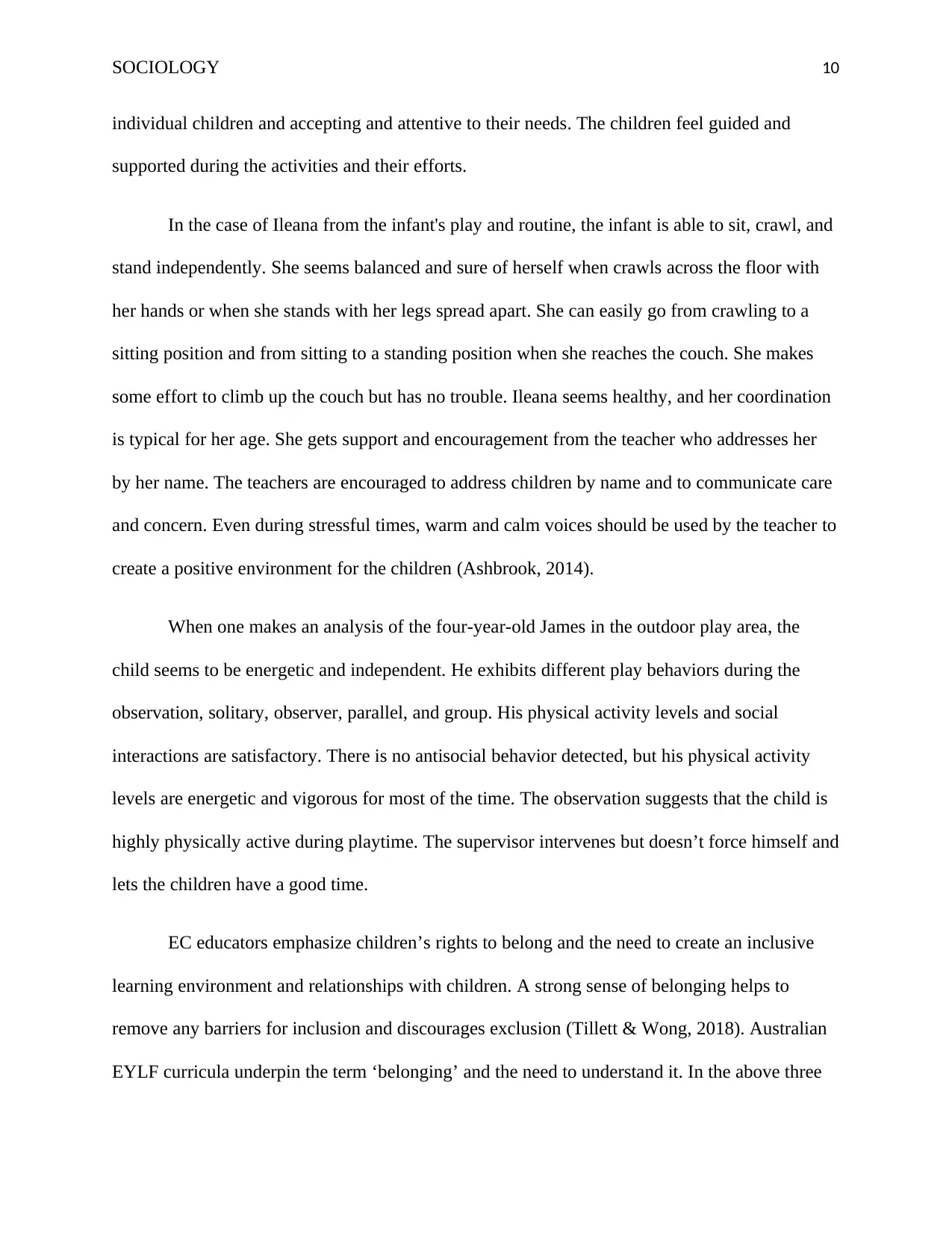
SOCIOLOGY 10
individual children and accepting and attentive to their needs. The children feel guided and
supported during the activities and their efforts.
In the case of Ileana from the infant's play and routine, the infant is able to sit, crawl, and
stand independently. She seems balanced and sure of herself when crawls across the floor with
her hands or when she stands with her legs spread apart. She can easily go from crawling to a
sitting position and from sitting to a standing position when she reaches the couch. She makes
some effort to climb up the couch but has no trouble. Ileana seems healthy, and her coordination
is typical for her age. She gets support and encouragement from the teacher who addresses her
by her name. The teachers are encouraged to address children by name and to communicate care
and concern. Even during stressful times, warm and calm voices should be used by the teacher to
create a positive environment for the children (Ashbrook, 2014).
When one makes an analysis of the four-year-old James in the outdoor play area, the
child seems to be energetic and independent. He exhibits different play behaviors during the
observation, solitary, observer, parallel, and group. His physical activity levels and social
interactions are satisfactory. There is no antisocial behavior detected, but his physical activity
levels are energetic and vigorous for most of the time. The observation suggests that the child is
highly physically active during playtime. The supervisor intervenes but doesn’t force himself and
lets the children have a good time.
EC educators emphasize children’s rights to belong and the need to create an inclusive
learning environment and relationships with children. A strong sense of belonging helps to
remove any barriers for inclusion and discourages exclusion (Tillett & Wong, 2018). Australian
EYLF curricula underpin the term ‘belonging’ and the need to understand it. In the above three
individual children and accepting and attentive to their needs. The children feel guided and
supported during the activities and their efforts.
In the case of Ileana from the infant's play and routine, the infant is able to sit, crawl, and
stand independently. She seems balanced and sure of herself when crawls across the floor with
her hands or when she stands with her legs spread apart. She can easily go from crawling to a
sitting position and from sitting to a standing position when she reaches the couch. She makes
some effort to climb up the couch but has no trouble. Ileana seems healthy, and her coordination
is typical for her age. She gets support and encouragement from the teacher who addresses her
by her name. The teachers are encouraged to address children by name and to communicate care
and concern. Even during stressful times, warm and calm voices should be used by the teacher to
create a positive environment for the children (Ashbrook, 2014).
When one makes an analysis of the four-year-old James in the outdoor play area, the
child seems to be energetic and independent. He exhibits different play behaviors during the
observation, solitary, observer, parallel, and group. His physical activity levels and social
interactions are satisfactory. There is no antisocial behavior detected, but his physical activity
levels are energetic and vigorous for most of the time. The observation suggests that the child is
highly physically active during playtime. The supervisor intervenes but doesn’t force himself and
lets the children have a good time.
EC educators emphasize children’s rights to belong and the need to create an inclusive
learning environment and relationships with children. A strong sense of belonging helps to
remove any barriers for inclusion and discourages exclusion (Tillett & Wong, 2018). Australian
EYLF curricula underpin the term ‘belonging’ and the need to understand it. In the above three
Paraphrase This Document
Need a fresh take? Get an instant paraphrase of this document with our AI Paraphraser
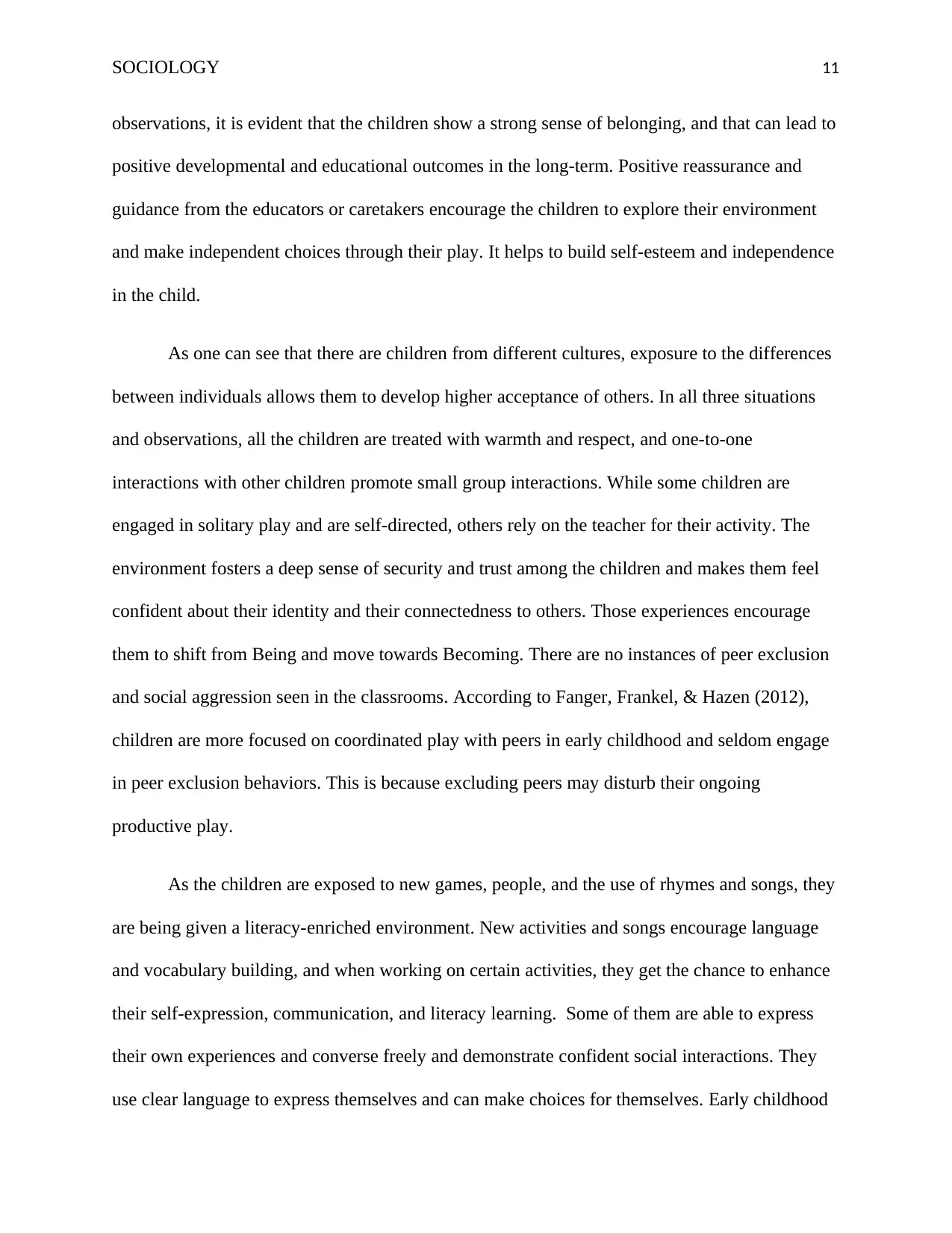
SOCIOLOGY 11
observations, it is evident that the children show a strong sense of belonging, and that can lead to
positive developmental and educational outcomes in the long-term. Positive reassurance and
guidance from the educators or caretakers encourage the children to explore their environment
and make independent choices through their play. It helps to build self-esteem and independence
in the child.
As one can see that there are children from different cultures, exposure to the differences
between individuals allows them to develop higher acceptance of others. In all three situations
and observations, all the children are treated with warmth and respect, and one-to-one
interactions with other children promote small group interactions. While some children are
engaged in solitary play and are self-directed, others rely on the teacher for their activity. The
environment fosters a deep sense of security and trust among the children and makes them feel
confident about their identity and their connectedness to others. Those experiences encourage
them to shift from Being and move towards Becoming. There are no instances of peer exclusion
and social aggression seen in the classrooms. According to Fanger, Frankel, & Hazen (2012),
children are more focused on coordinated play with peers in early childhood and seldom engage
in peer exclusion behaviors. This is because excluding peers may disturb their ongoing
productive play.
As the children are exposed to new games, people, and the use of rhymes and songs, they
are being given a literacy-enriched environment. New activities and songs encourage language
and vocabulary building, and when working on certain activities, they get the chance to enhance
their self-expression, communication, and literacy learning. Some of them are able to express
their own experiences and converse freely and demonstrate confident social interactions. They
use clear language to express themselves and can make choices for themselves. Early childhood
observations, it is evident that the children show a strong sense of belonging, and that can lead to
positive developmental and educational outcomes in the long-term. Positive reassurance and
guidance from the educators or caretakers encourage the children to explore their environment
and make independent choices through their play. It helps to build self-esteem and independence
in the child.
As one can see that there are children from different cultures, exposure to the differences
between individuals allows them to develop higher acceptance of others. In all three situations
and observations, all the children are treated with warmth and respect, and one-to-one
interactions with other children promote small group interactions. While some children are
engaged in solitary play and are self-directed, others rely on the teacher for their activity. The
environment fosters a deep sense of security and trust among the children and makes them feel
confident about their identity and their connectedness to others. Those experiences encourage
them to shift from Being and move towards Becoming. There are no instances of peer exclusion
and social aggression seen in the classrooms. According to Fanger, Frankel, & Hazen (2012),
children are more focused on coordinated play with peers in early childhood and seldom engage
in peer exclusion behaviors. This is because excluding peers may disturb their ongoing
productive play.
As the children are exposed to new games, people, and the use of rhymes and songs, they
are being given a literacy-enriched environment. New activities and songs encourage language
and vocabulary building, and when working on certain activities, they get the chance to enhance
their self-expression, communication, and literacy learning. Some of them are able to express
their own experiences and converse freely and demonstrate confident social interactions. They
use clear language to express themselves and can make choices for themselves. Early childhood
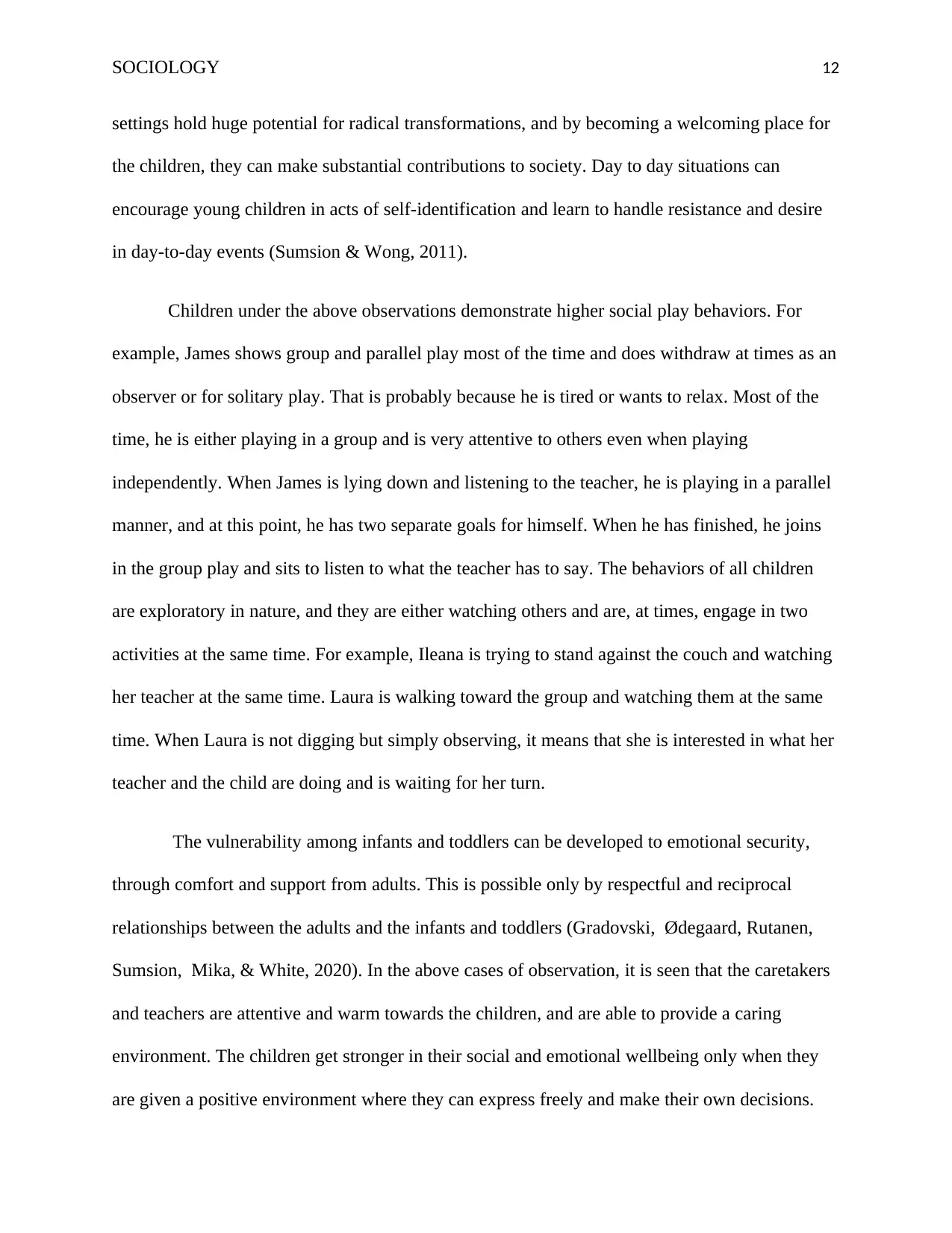
SOCIOLOGY 12
settings hold huge potential for radical transformations, and by becoming a welcoming place for
the children, they can make substantial contributions to society. Day to day situations can
encourage young children in acts of self-identification and learn to handle resistance and desire
in day-to-day events (Sumsion & Wong, 2011).
Children under the above observations demonstrate higher social play behaviors. For
example, James shows group and parallel play most of the time and does withdraw at times as an
observer or for solitary play. That is probably because he is tired or wants to relax. Most of the
time, he is either playing in a group and is very attentive to others even when playing
independently. When James is lying down and listening to the teacher, he is playing in a parallel
manner, and at this point, he has two separate goals for himself. When he has finished, he joins
in the group play and sits to listen to what the teacher has to say. The behaviors of all children
are exploratory in nature, and they are either watching others and are, at times, engage in two
activities at the same time. For example, Ileana is trying to stand against the couch and watching
her teacher at the same time. Laura is walking toward the group and watching them at the same
time. When Laura is not digging but simply observing, it means that she is interested in what her
teacher and the child are doing and is waiting for her turn.
The vulnerability among infants and toddlers can be developed to emotional security,
through comfort and support from adults. This is possible only by respectful and reciprocal
relationships between the adults and the infants and toddlers (Gradovski, Ødegaard, Rutanen,
Sumsion, Mika, & White, 2020). In the above cases of observation, it is seen that the caretakers
and teachers are attentive and warm towards the children, and are able to provide a caring
environment. The children get stronger in their social and emotional wellbeing only when they
are given a positive environment where they can express freely and make their own decisions.
settings hold huge potential for radical transformations, and by becoming a welcoming place for
the children, they can make substantial contributions to society. Day to day situations can
encourage young children in acts of self-identification and learn to handle resistance and desire
in day-to-day events (Sumsion & Wong, 2011).
Children under the above observations demonstrate higher social play behaviors. For
example, James shows group and parallel play most of the time and does withdraw at times as an
observer or for solitary play. That is probably because he is tired or wants to relax. Most of the
time, he is either playing in a group and is very attentive to others even when playing
independently. When James is lying down and listening to the teacher, he is playing in a parallel
manner, and at this point, he has two separate goals for himself. When he has finished, he joins
in the group play and sits to listen to what the teacher has to say. The behaviors of all children
are exploratory in nature, and they are either watching others and are, at times, engage in two
activities at the same time. For example, Ileana is trying to stand against the couch and watching
her teacher at the same time. Laura is walking toward the group and watching them at the same
time. When Laura is not digging but simply observing, it means that she is interested in what her
teacher and the child are doing and is waiting for her turn.
The vulnerability among infants and toddlers can be developed to emotional security,
through comfort and support from adults. This is possible only by respectful and reciprocal
relationships between the adults and the infants and toddlers (Gradovski, Ødegaard, Rutanen,
Sumsion, Mika, & White, 2020). In the above cases of observation, it is seen that the caretakers
and teachers are attentive and warm towards the children, and are able to provide a caring
environment. The children get stronger in their social and emotional wellbeing only when they
are given a positive environment where they can express freely and make their own decisions.
⊘ This is a preview!⊘
Do you want full access?
Subscribe today to unlock all pages.

Trusted by 1+ million students worldwide
1 out of 15
Your All-in-One AI-Powered Toolkit for Academic Success.
+13062052269
info@desklib.com
Available 24*7 on WhatsApp / Email
![[object Object]](/_next/static/media/star-bottom.7253800d.svg)
Unlock your academic potential
Copyright © 2020–2025 A2Z Services. All Rights Reserved. Developed and managed by ZUCOL.
